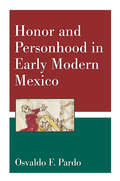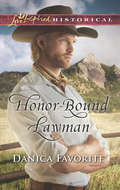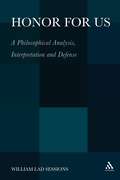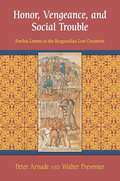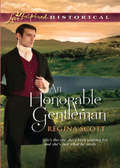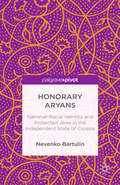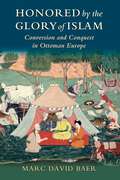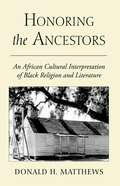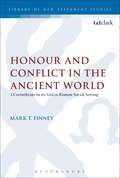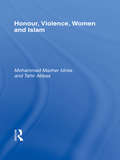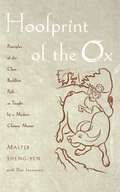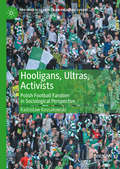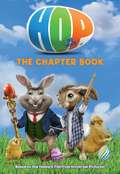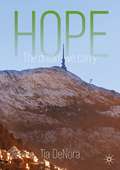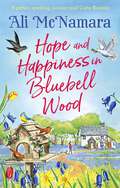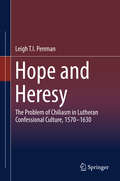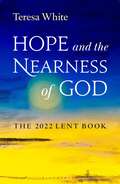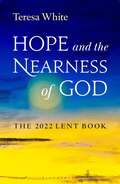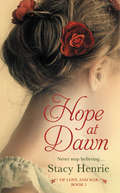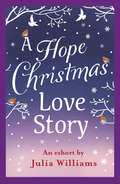- Table View
- List View
Honor and Personhood in Early Modern Mexico
by Osvaldo F. PardoOsvaldo F. Pardo examines the early dissemination of European views on law and justice among Mexico’s native peoples. Newly arrived from Spain in the sixteenth and seventeenth centuries, mendicant friars brought not only their faith in the authority of the Catholic Church but also their reverence of the monarchy. Drawing on a rich range of documents dating from this era—including secular and ecclesiastical legislation, legal and religious treatises, bilingual catechisms, grammars on indigenous languages, historical accounts, and official reports and correspondence—Pardo finds that honor, as well as related notions such as reputation, came to play a central role in shaping the lives and social relations of colonists and indigenous Mexicans alike. Following the application and adaptation of European ideas of justice and royal and religious power as they took hold in the New World, Pardo sheds light on the formation of colonial legalities and long-lasting views, both secular and sacred, that still inform attitudes toward authority in contemporary Mexican society.
Honor-Bound Lawman (Mills And Boon Love Inspired Historical Ser. #1)
by Danica FavoriteHer Rancher Bodyguard
Honor For Us: A Philosophical Analysis, Interpretation and Defense
by William Lad SessionsHonor For Us is the first contemporary philosophical inquiry into the concept of honor. It is unique not only in its analysis of six distinct concepts of honor, which includes an investigation into the place of honor in religious thought and ethics, but also in its interpretation of honor's prevalence in our own culture. Many would like to discard honor altogether as 'obsolete', but Sessions contends that the concept of honor is poorly understood, standing sorely in need of clarification. He argues that the notion of honor remains viable in the face of powerful criticism, and that it has important features which warrant our normative interest. While not downplaying the 'dark side' of honor (violence, sexism, inegalitarianism, its abuse in religion), Sessions shows that honor not only constitutes a descriptively useful concept but also remains a potentially valuable concept for us today.
Honor, Vengeance, and Social Trouble: Pardon Letters in the Burgundian Low Countries
by Peter Arnade Walter PrevenierAmong the more intriguing documentary sources from late medieval Europe are pardon letters—petitions sent by those condemned for serious crimes to monarchs and princes in France and the Low Countries in the hopes of receiving a full pardon. The fifteenth-century Burgundian Low Countries and duchy of Burgundy produced a large cache of these petitions, from both major cities (Bruges, Ghent, Antwerp, and Dijon) and rural communities. In Honor, Vengeance, and Social Trouble, Peter Arnade and Walter Prevenier present the first study in English of these letters to explore and interrogate the boundaries between these sources’ internal, discursive properties and the social world beyond the written text. Honor, Vengeance, and Social Trouble takes the reader out onto the streets and into the taverns, homes, and workplaces of the Burgundian territories, charting the most pressing social concerns of the day: everything from family disputes and vendettas to marital infidelity and property conflicts—and, more generally, the problems of public violence, abduction and rape, and the role of honor and revenge in adjudicating disputes. Arnade and Prevenier examine why the right to pardon was often enacted by the Burgundian dukes and how it came to compete with more traditional legal means of resolving disputes. In addition, they consider the pardon letter as a historical source, highlighting the limitations and pitfalls of relying on documents that are, by their very nature, narratives shaped by the petitioner to seek a favored outcome. The book also includes a detailed case study of a female actress turned prostitute. An example of microhistory at its best, Honor, Vengeance, and Social Trouble will challenge scholars while being accessible to students in courses on medieval and early modern Europe or on historiography.
Honorary Aryans: National-Racial Identity and Protected Jews in the Independent State of Croatia
by N. BartulinFrom 1941 to 1945, a small number of Jews were given the rights of Aryan citizens in Croatia by the pro-Nazi Utasha regime. This study seeks to explain why these exemptions from Ustasha racial laws came to be, how they were justified by the race theory of the time, and how the "Croats of the Mosaic faith" were eventually rejected as racial aliens.
Honored by the Glory of Islam
by Marc David BaerIn Honored by the Glory of Islam Marc David Baer proposes a novel approach to the historical record of Islamic conversions during the Ottoman age and gathers fresh insights concerning the nature of religious conversion itself. Rather than explaining Ottoman Islamization in terms of the converts' motives, Baer instead concentrates on the proselytizers -- in this case, none other than the sultan himself. Mehmed IV (1648-87) is remembered as an aloof ruler whose ineffectual governing led to the disastrous siege of Vienna. Through an integrated reading of previously unexamined Ottoman archival and literary texts, Baer reexamines Mehmed IV's failings as a ruler by underscoring the sultan's zeal for bringing converts to Islam. As an expression of his dedication to Islam, Mehmed actively sought to establish his reputation as a convert-maker, convincing or compelling Christian and Jewish subjects to be "honored by the glory of Islam" and Muslims subjects to turn to Islamic piety. Revising the conventional portrayal of a ruler so distracted by his passion for hunting that he neglected affairs of state, Baer shows that Mehmed IV saw conversion as central to his role as sultan. He traces an ever-widening range of enforced piety, conversion, and conquest expanding outward from the heart of Mehmed IV's empire. This account is the first to correlate the conversion of people and space in the mature Ottoman Empire, to investigate conversion from the perspective of changing Ottoman ideology, and to depict the sultan as an interventionist convert-maker. The resulting insights promise to rework our understandings of the reign of a forgotten ruler, a largely neglected period in Ottoman history, the changing nature of Islam and its history in Europe, relations between Muslims, Christians, and Jews in Europe, the practice of jihad, and religious architecture in urban history.
Honored by the Glory of Islam
by Marc David BaerIn Honored by the Glory of Islam Marc David Baer proposes a novel approach to the historical record of Islamic conversions during the Ottoman age and gathers fresh insights concerning the nature of religious conversion itself. Rather than explaining Ottoman Islamization in terms of the converts' motives, Baer instead concentrates on the proselytizers -- in this case, none other than the sultan himself. Mehmed IV (1648-87) is remembered as an aloof ruler whose ineffectual governing led to the disastrous siege of Vienna. Through an integrated reading of previously unexamined Ottoman archival and literary texts, Baer reexamines Mehmed IV's failings as a ruler by underscoring the sultan's zeal for bringing converts to Islam. As an expression of his dedication to Islam, Mehmed actively sought to establish his reputation as a convert-maker, convincing or compelling Christian and Jewish subjects to be "honored by the glory of Islam" and Muslims subjects to turn to Islamic piety. Revising the conventional portrayal of a ruler so distracted by his passion for hunting that he neglected affairs of state, Baer shows that Mehmed IV saw conversion as central to his role as sultan. He traces an ever-widening range of enforced piety, conversion, and conquest expanding outward from the heart of Mehmed IV's empire. This account is the first to correlate the conversion of people and space in the mature Ottoman Empire, to investigate conversion from the perspective of changing Ottoman ideology, and to depict the sultan as an interventionist convert-maker. The resulting insights promise to rework our understandings of the reign of a forgotten ruler, a largely neglected period in Ottoman history, the changing nature of Islam and its history in Europe, relations between Muslims, Christians, and Jews in Europe, the practice of jihad, and religious architecture in urban history.
Honoring the Ancestors: An African Cultural Interpretation of Black Religion and Literature
by Donald H. MatthewsDonald Matthews affirms once and for all the African foundation of African-American religious practice. His analysis of the methods employed by historians, social scientists, and literary critics in the study of African-American religion and the Negro spiritual leads him to develop a methodology that encompasses contemporary scholarship without compromising the integrity of African-American religion and culture. Because the Negro spiritual is the earliest extant body of African-American folk religious narration, Matthews believes that it holds the key to understanding African-American religion. He explores the works of such seminal black scholars as W. E. B. DuBois, Melville Herskovits, and Zora Neale Hurston, tracing the early development of the African-centered approach to the interpretation of African-American religion. This approach involves "cultural/structuralism", the author's term for the method used by DuBois, Herskovits, and Hurston that emphasizes the thick reading of narrative expressions. Such a reading allows the scholar to identify the cultural significance of particular oral and written texts and serves as a point of identification and a cultural link between African and African-American religion. Matthews' close analysis of the spiritual employs a dialectical and postmodernist reading and reveals a religious philosophy that addresses the deepest concerns and desires of Africans in America. These concerns are cultural, political, and psychological, but are ultimately related to African religious structures of meaning. This book poses a challenge to end the battle between Afrocentrists and multiculturalists by acknowledging their common intellectual heritage in the works of DuBois, Herskovits, and Hurston. It will be of great interest to students and scholars of African-American religion and culture and those interested in Afrocentric literature.
Honour and Conflict in the Ancient World: 1 Corinthians in its Greco-Roman Social Setting (The Library of New Testament Studies #460)
by Mark T. FinneyIn this volume, Finney argues that the conflict in 1 Corinthians is driven by lust for honour and Paul's use of the paradigm of the cross. Studies in contemporary social anthropology have noted the importance of male honour and how this is able to generate ideas of social identity within a community and to elucidate patterns of social behaviour. Finney examines the letter of 1 Corinthians , which presents a unique expose of numerous aspects of social life in the first-century Greco-Roman world where honour was of central importance. At the same time, filotimia (the love and lust for honour) also had the capacity to generate an environment of competition, antagonism, factionalism, and conflict, all of which are clearly evident within the pages of 1 Corinthians . Finney seeks to examine the extent to which the social constraints of filotimia, and its potential for conflict, lay behind the many problems evident within the nascent Christ-movement at Corinth. Finney presents a fresh reading of the letter, and the thesis it proposes is that the honour-conflict model, hitherto overlooked in studies on 1 Corinthians , provides an appropriate and compelling framework within which to view the many disparate aspects of the letter in their social context. Formerly the Journal for the Study of the New Testament Supplement , this is a book series that explores the many aspects of New Testament study including historical perspectives, social-scientific and literary theory, and theological, cultural and contextual approaches.
Honour, Violence, Women And Islam
by Mohammad Mazher Idriss Tahir Abbas Ross AbbinnettWhy are honour killings and honour-related violence (HRV) so important to understand? What do such crimes represent? And how does HRV fit in with Western views and perceptions of Islam? This distinctively comparative collection examines the concept of HRV against women in general and Muslim women in particular. The issue of HRV has become a sensitive subject in many South Asian and Middle Eastern countries and it has received the growing attention of the media, human rights groups and academics around the globe. However, the issue has yet to receive detailed academic study in the United Kingdom, particularly in terms of both legal and sociological research. This collection sets out the theoretical and ethical parameters of the study of HRV in order to address this intellectual vacuum in a socio-legal context. The key objectives of this book are: to construct, and to develop further, a theory of HRV; to rationalise and characterise the different forms of HRV; to investigate the role of religion, race and class in society within this context, in particular, the role of Islam; to scrutinise the role of the civil/criminal law/justice systems in preventing these crimes; and to inform public policy-makers of the potential policies that may be employed in combating HRV.
Honour, Violence, Women And Islam (PDF)
by Mohammad Mazher Idriss Tahir Abbas Ross AbbinnettWhy are honour killings and honour-related violence (HRV) so important to understand? What do such crimes represent? And how does HRV fit in with Western views and perceptions of Islam? This distinctively comparative collection examines the concept of HRV against women in general and Muslim women in particular. The issue of HRV has become a sensitive subject in many South Asian and Middle Eastern countries and it has received the growing attention of the media, human rights groups and academics around the globe. However, the issue has yet to receive detailed academic study in the United Kingdom, particularly in terms of both legal and sociological research. This collection sets out the theoretical and ethical parameters of the study of HRV in order to address this intellectual vacuum in a socio-legal context. The key objectives of this book are: to construct, and to develop further, a theory of HRV; to rationalise and characterise the different forms of HRV; to investigate the role of religion, race and class in society within this context, in particular, the role of Islam; to scrutinise the role of the civil/criminal law/justice systems in preventing these crimes; and to inform public policy-makers of the potential policies that may be employed in combating HRV.
Hoofprint of the Ox: Principles of the Chan Buddhist Path as Taught by a Modern Chinese Master
by Master Sheng-yenRevered by Buddhists in the United States and China, Master Sheng-yen shares his wisdom and teachings in this first comprehensive English primer of Chan, the Chinese tradition of Buddhism that inspired Japanese Zen. Often misunderstood as a system of mind games, the Chan path leads to enlightenment through apparent contradiction. While demanding the mental and physical discipline of traditional Buddhist doctrine, it asserts that wisdom (Buddha-nature) is innate and immediate in all living beings, and thus not to be achieved through devotion to the strictures of religious practice. You arrive without departing. Master Sheng-yen provides an unprecedented understanding of Chan, its precepts, and its practice. Beginning with a basic overview of Buddhism and meditation, Hoofprint of the Ox details the progressive mental exercises traditionally followed by all Buddhists. Known as the Three Disciplines, these procedures develop moral purity, meditative concentration, and enlightening insight through the "stilling" of the mind. Master Sheng-yen then expounds Chan Buddhism, recounting its centuries-old history in China and illuminating its fundamental tenets. He contemplates the nature of Buddhahood, specifies the physical and mental prerequisites for beginning Chan practice, and humbly considers what it means to be an enlightened Chan master. Drawing its title from a famous series of pictures that symbolizes the Chan path as the search of an ox-herd for his wayward ox, Hoofprint of the Ox is an inspirational guide to self-discovery through mental transformation. A profound contribution to Western understanding of Chan and Zen, this book is intended for practicing Buddhists as well as anyone interested in learning about the Buddhist path.
Hooligans, Ultras, Activists: Polish Football Fandom in Sociological Perspective (Football Research in an Enlarged Europe)
by Radosław KossakowskiThis book is the first comprehensive attempt to identify the deeper causes that have shaped contemporary behaviour patterns and motivations among football fans in Poland. Fan culture in Poland has long been based on a distinctively grassroots, spontaneous movements that ruled out any cooperation with local authorities and sports organizations. The activity of supporter groups has regularly failed to meet the principles set by official bodies, intentionally breaching the moral and legal standards of the day. Based on data derived from ethnographic fieldwork, content analysis of fan journals, magazines, social media and online forums, as well as a wide range of qualitative interviews conducted over the years, the book analyses the ways in which fandom culture in Poland has evolved: from its moderate beginnings in the shadows of a communist regime in the 1970’s, through the anomic, ‘uncivilized’ and pathological decade of the 1990’s, to the peculiar culture based on strong cohesion, capabilities of social mobilization and emerging 'resistance identity' in the 21st century. It thus provides a detailed analysis of Polish fandom’s multi-dimensional structure, and will be of interest to students and academics interested in the growing field of football research, as well as those researching the transformation of Central and Eastern Europe, or more generally in European Studies.
Hooray for Hoppy: A First Book of Senses
by Tim HopgoodWhen Hoppy the rabbit wakes up on the first day of spring, he discovers a world full of wonderful things! But after he's sniffed the fresh air, listened to the singing birds and tasted the fresh green grass, he starts to feel a little lonely. And so he finds a way to wake up his friends so they can enjoy the sights, smells and sounds of spring all together.Hooray for Hoppy by Tim Hopgood is a bold and beautiful introduction to the senses and includes an activity spread to help children learn all about the way they can use their senses to interact with the world around them. The stunning artwork has a retro charm that will appeal to all ages.Discover more from Tim Hopgood, the Booktrust award-winning illustrator of WOW! Said The Owl, a first book of colours, and TIP TAP Went The Crab, a first book of counting.
Hop: The Chapter Book (Hop)
by Annie AuerbachEaster Island is home to the Easter Bunny's magical workshop--where do you think Santa got all his good ideas? Easter bunny Jr., aka E.B. (Russell Brand), would rather pursue his dream of becoming a rock star than hop along in his father's footsteps. Fred (James Marsden), an unemployed slacker, is trying to figure out what to do with his life when he accidentally injures the soon to be Easter Bunny and decides he's the one to take over the job. When these two collide, E.B. and Fred both discover what it takes to grow up.
Hope: The Dream We Carry
by Tia DeNoraThis book provides a concise, interdisciplinary perspective on the emotion and practice of ‘hope'. Based on the idea that hope is a dream that we carry in different ways, the five chapters draw on the author’s original research and align it with literature on the sociology of culture and emotion, to explore the concept in relation to cultural and community practices and mental health.The climate crisis, violence, hostility, pandemics, homelessness, displacement, conflict, slavery, economic hardship and economic downturn, loneliness, anxiety, mental illness – are intensifying. There is a need for hope. There is also a need to confront hope - what is hope and what can, and cannot, be achieved by hoping. This confrontation includes distinguishing hope from wishful thinking and blind optimism. Using examples from different spheres of social life, including health, religion, music therapy, migration and social displacement, the book sets the idea of hope in context of situations of uncertainty, challenge and pain, and goes on to highlight the practical application of these ideas and outline an agenda for further research on ‘hope'.
Hope and Grace: Spiritual Experiences in Severe Distress, Illness and Dying
by Monika RenzIntroducing a specialised approach to the spiritual care of patients, this book explores how you can understand different types of spiritual experience among suffering patients and engage with them creatively as an essential part of good care. Case studies enable you to work confidently with religious and non-religious people in your care.
Hope and Happiness in Bluebell Wood: the most uplifting and joyful read of the summer
by Ali McNamaraAn Ali McNamara novel is the perfect escape.Welcome to Bluebell Wood where the sun shines, the locals are kind and there's something more than a little bit magical about the place.Ava loves city life but when something happens to make her feel unsafe, she retreats to the calm and quiet of Bluebell Wood. The once high-flying Ava now locks herself away in her fairy-tale cottage, only leaving to explore the trails of the nearby woods or to potter in the garden with her dog, Merlin. When Ava begins to feed the wild birds that flock to her bird table, they start leaving her trinkets of appreciation in return. The gifts seem innocent at first, but they soon seem to take on a deeper meaning. It isn't until Ava meets Callum, the handsome parish priest, that she can't help but wonder if the birds might have been trying to get her out of the house all along. But will their curious behaviour help to heal Ava, and transform her and Callum into the lovebirds they clearly long to be?Praise for Ali McNamara:An enchanting escape. Pure magic!' Heidi Swain'A perfect, sparkling, summer read.' Cathy Bramley'Fun and endearing' Katie Fforde'Perfect easy reading' SunAn irresistible, feel-good story infused with infectious humour' Miranda Dickinson'Funny and light-hearted' Heat
Hope and Heresy: The Problem of Chiliasm in Lutheran Confessional Culture, 1570–1630
by Leigh T.I. PenmanApocalyptic expectations played a key role in defining the horizons of life and expectation in early modern Europe. Hope and Heresy investigates the problematic status of a particular kind of apocalyptic expectation—that of a future felicity on earth before the Last Judgement—within Lutheran confessional culture between approximately 1570 and 1630.Among Lutherans expectations of a future felicity were often considered manifestations of a heresy called chiliasm, because they contravened the pessimistic apocalyptic outlook at the core of confessional identity. However, during the late sixteenth and early seventeenth centuries, individuals raised within Lutheran confessional culture—mathematicians, metallurgists, historians, astronomers, politicians, and even theologians—began to entertain and publicise hopes of a future earthly felicity. Their hopes were countered by accusations of heresy. The ensuing contestation of acceptable doctrine became a flashpoint for debate about the boundaries of confessional identity itself.Based on a thorough study of largely neglected or overlooked print and manuscript sources, the present study examines these debates within their intellectual, social, cultural, and theological contexts. It outlines, for the first time, a heretofore overlooked debate about the limits and possibilities of eschatological thought in early modernity, and provides readers with a unique look at a formative time in the apocalyptic imagination of European culture.
Hope and the Nearness of God: The 2022 Lent Book
by Teresa WhiteIn these days of pandemic, war and political turbulence, hope can seem to be in short supply. But hope is one of the theological virtues and it is far more profound than mere optimism. Today, pessimism and despair seem all too prevalent. What can we do about the poor and starving, about those who seem to be locked in interminable conflict and families weighed down by the consequences of breakdown?Sister Teresa White's book is an antidote to all this and it is written with beautiful simplicity and directness. There is no hiding behind complicated or technical language. In one of the most forceful chapters in the book, the author shows how hope breeds courage and courage breeds hope. But hope is not a matter of wishful thinking. Drawing on St Augustine, the author shows moreover that hope has two essential components. Not just courage but anger as well. The expression of our anger can lead to greater clarity with our discernment and spiritual perception. Hope too can lead us to understand God's solidarity with us in times of sorrow and struggle.Teresa White in this Lent Book draws on inspiration from writers as diverse as Julian of Norwich and Karl Rahner, Elizabeth Barrett-Browning and Henri Nouwen, but throughout the book there is strong scriptural underpinning which the author uses to great effect.
Hope and the Nearness of God: The 2022 Lent Book
by Teresa WhiteIn these days of pandemic, war and political turbulence, hope can seem to be in short supply. But hope is one of the theological virtues and it is far more profound than mere optimism. Today, pessimism and despair seem all too prevalent. What can we do about the poor and starving, about those who seem to be locked in interminable conflict and families weighed down by the consequences of breakdown?Sister Teresa White's book is an antidote to all this and it is written with beautiful simplicity and directness. There is no hiding behind complicated or technical language. In one of the most forceful chapters in the book, the author shows how hope breeds courage and courage breeds hope. But hope is not a matter of wishful thinking. Drawing on St Augustine, the author shows moreover that hope has two essential components. Not just courage but anger as well. The expression of our anger can lead to greater clarity with our discernment and spiritual perception. Hope too can lead us to understand God's solidarity with us in times of sorrow and struggle.Teresa White in this Lent Book draws on inspiration from writers as diverse as Julian of Norwich and Karl Rahner, Elizabeth Barrett-Browning and Henri Nouwen, but throughout the book there is strong scriptural underpinning which the author uses to great effect.
Hope at Dawn (Of Love and War #1)
by Stacy HenrieIN A TIME OF WAR, LOVE IS THE INSPIRATION. With her brothers away fighting the Great War overseas, Livy Campbell desperately wants to help her family. Her chance comes when she meets a handsome stranger who lands her a job as a teacher in a place far from her parents' farm. But the war casts a long shadow over the German-American town that Livy now calls home-and the darkness will test everything she thought she knew about family and love . . . More than anything, Friedrick Wagner wants to be part of his adopted country's struggle for peace. But when the bitter animosity between Germans and Americans soon turns citizens against newcomers, friend against friend, he will do whatever it takes to protect Livy from the hysteria that grips their town. As tragedy-and dark secrets from the past-threaten their future, Friedrick and Livy have one chance to stand up for what's right . . . and one chance to fight for their love.
A Hope Christmas Love Story
by Julia WilliamsA sparkling festive short story that will make your heart melt. Perfect for fans of Trisha Ashley and Jenny Colgan.
Hope for Everyone: A Fresh Vision of the Afterlife
by David Bell Dave GriffithsHave you ever imagined what the afterlife might be like? It is something that people throughout history have often pondered. Where, why and how might we live again? Who would we be with? What would we do? What about God, Heaven and Hell? The prospect of the afterlife raises so many questions. Hope for Everyone is a story that seeks to address these questions. It follows the afterlives of four main characters and explores a process of reconciliation that is both plausible and in line with the logic of love that has been given to humanity through the ages. How can a soldier who dies in battle be reconciled with those on the other side? How can a gangster live in harmony with the woman he has killed? How can a former slave girl walk side by side with her abuser? How can a proud religious housewife learn to let go of her prejudices? By imagining a possible future that leads to abundant life for all, this book aims to bring hope to everyone. Some readers have compared it to the Shack. Though this world can seem bleak, this tale offers a challenging and thrilling possibility that eventually everyone will love everyone.
